The ASUS ROG Strix GL502VS Review: Mainstream GTX 1070 with G-SYNC
by Brett Howse on December 9, 2016 8:00 AM ESTGPU Performance
The big update with the GL502VS over the previous model is NVIDIA’s new Pascal based GTX 1070, replacing the outgoing GTX 980M on the GL502VY. We’ve gone over this before when the GTX 10-series launched for notebooks, but this is a significant departure from previous mobile GPUs from NVIDIA. We’ve seen this coming over the years, with mobile GPUs and desktop GPUs being based on the same architecture, and the performance delta between them shrinking every year, but with the release of the 10-series, NVIDIA has dropped the M branding for mobile.
This doesn’t mean it’s the same GPU in a notebook as a desktop, but in NVIDIA’s eyes, the performance of the desktop and notebook part are close enough that they feel they can brand them the same. It also makes it easier for the consumer, because a GTX 1070 is a GTX 1070, more or less, when discussing performance, where as the GTX 980M was a pretty big step down from the GTX 980 (which did eventually find its way into high end gaming notebooks near the end of its life). The notebook version of the GTX 1070 is one of the most interesting of the bunch, since it actually has more CUDA cores than the desktop part, at 2048 compared to 1920 on the desktop. The core and boost clock are a bit lower than the desktop part, which means NVIDIA went for a bit of a wide and slow approach to meet their TDP goals, although that is all relative, since it’s far from slow.
The ASUS GL502VS was put through the notebook workload for GPUs, with a couple of new games added as well. To compare it to any other notebook we’ve tested, please use our online bench. First up is some synthetic tests, followed by gaming results.
3DMark
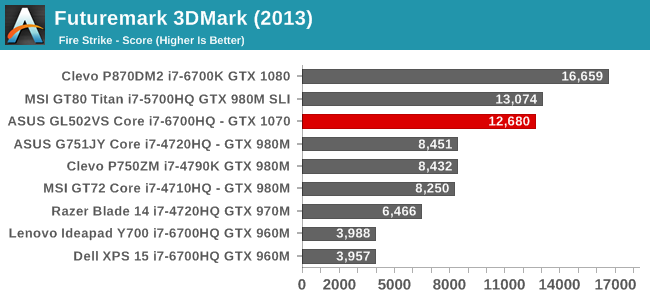
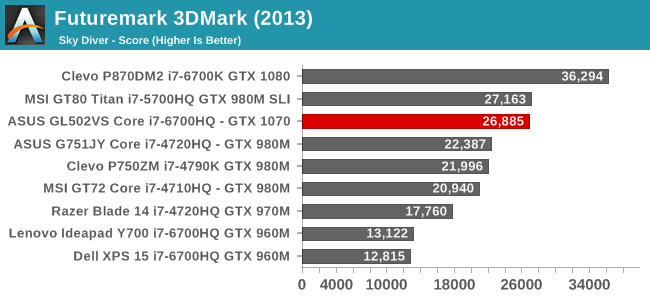
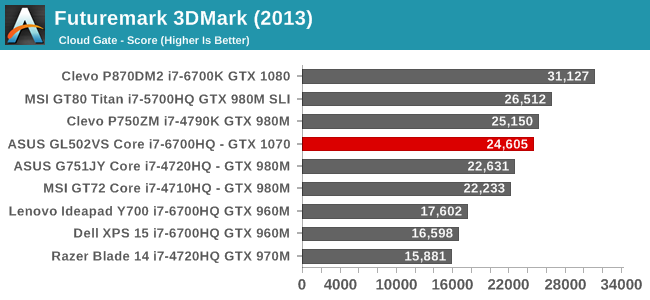
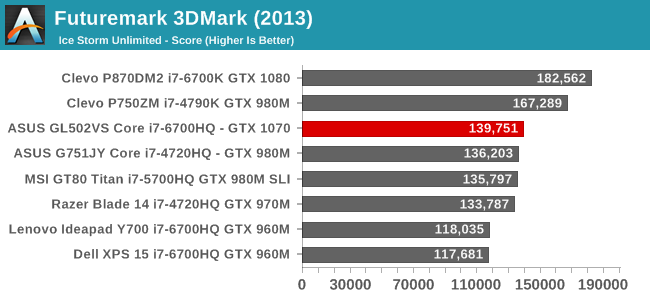
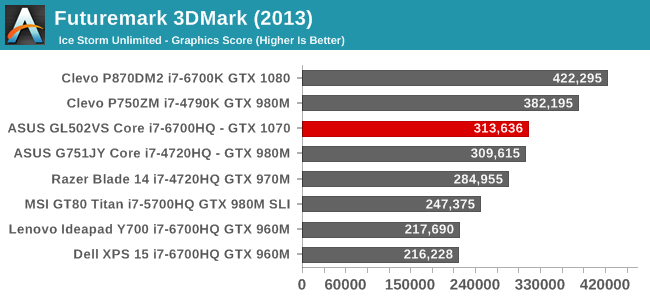
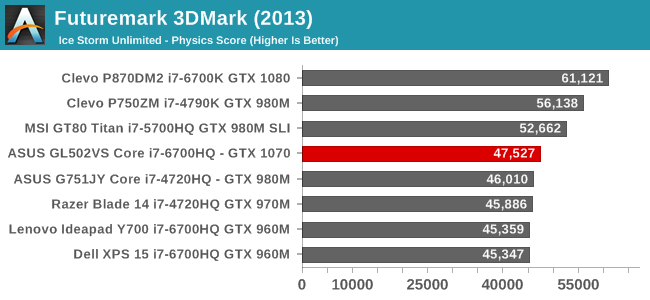
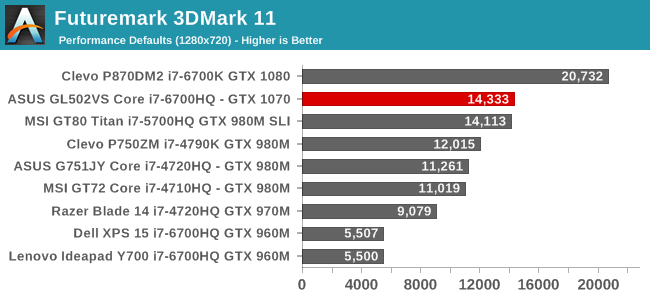
With the more difficult tests of Fire Strike and Sky Diver, the GTX 1070 is within spitting distance of the MSI GT80 Titan with SLI GTX 980M, showing just what a jump in performance the GTX 1070 is. One step under the GTX 1080, and there is still roughly the same performance as the best SLI laptop available with Maxwell. Not a bad start.
GFXBench
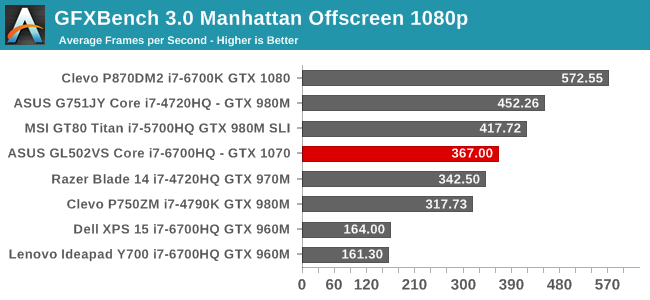
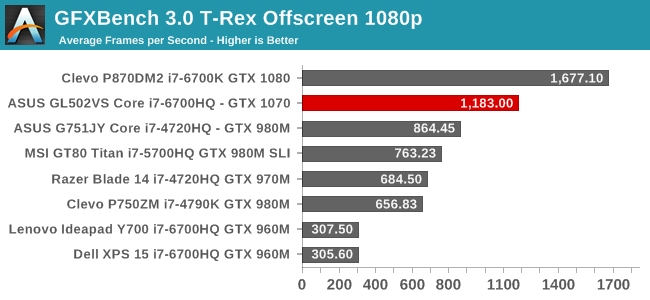
Both of the tests from the older version of GFXBench are really starting to show their age, with scores that are on the far side of ridiculous. The T-Rex scores are kind of insane for both of the Pascal laptops, with results well over 1000 frames per second. The latest version of the test includes some more difficult rendering, and this version will be the new default very soon.
Dota 2 Reborn
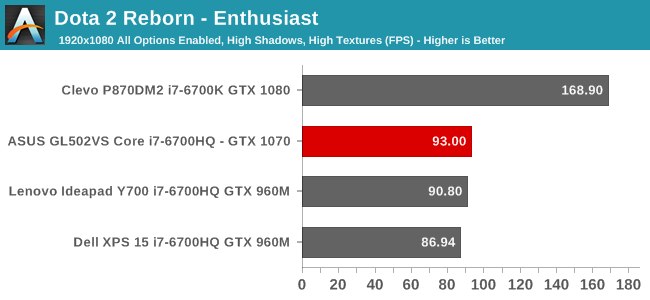
Valve updated the Dota 2 engine quite a while back now, and despite their best efforts, it is still largely a CPU bound test. The GTX 1070 would normally run laps around a GTX 960M, but they are within a couple frames per second of each other with the same CPU available, while the Clevo runs away with this test thanks to the inclusion of a desktop class 95-Watt processor.
Tomb Raider

Although several years old, with everything at maximum Tomb Raider can still be punishing to slower graphics processing units, but with the benefits of Pascal and a much more power efficient architecture, the ASUS GL502VS is once again right on the heels of the SLI GTX 980M found in the GT80 Titan. That seems to be a pretty consistent result, which is very impressive for a mid-range GPU.
Rise of the Tomb Raider

The latest version of Tomb Raider is a beautiful game to look at, especially with everything at maximum. The ASUS compares very well here, still averaging almost 100 frames per second. Be warned though, ASUS does offer a version of this laptop with a 4 GB GPU, and you need more than 4 GB of memory to run this game at its maximum settings, so be sure to future proof yourself with an 8 GB model.
Civilization VI



Although the game is new, the underlying engine is pretty much the same, and Civilization continues to be a mostly CPU bound game. Since the last review of the GTX 1080 Clevo, the benchmark has been updated and the scores from that system are no longer valid, so for the time being there is just a single result here, but as you can see there is very little difference between maximum settings and minimum, as far as frame rate. Interestingly they’ve also added a new test to determine the average amount of time between turns, and that should be useful for future reviews as a CPU test.
Bioshock Infinite
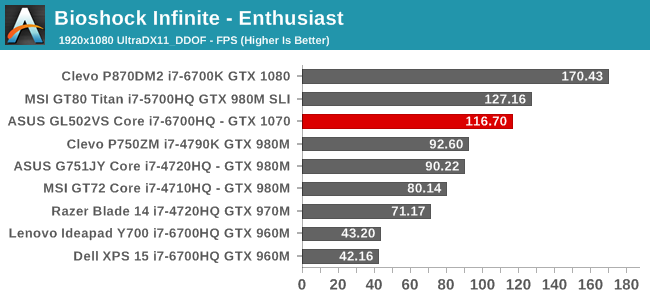
Once again this game is getting a bit old, but it’s still very fun, and can be quite demanding at maximum settings. Pascal is really taking this game for granted though, as even on the maximum settings the frame rate is still very high, and once again it is right behind SLI GTX 980M.
Dragon Age: Inquisition
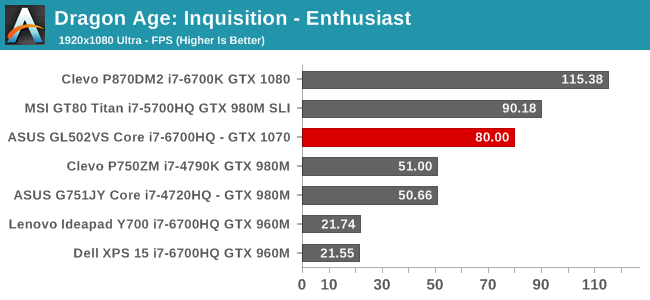
Although behind the GT80 Titan, the ASUS GL502VS is very much right up there when playing this amazing RPG from the end of 2014. There is a healthy step up from the GTX 980M, and the GTX 960M cards aren’t even playable at these settings.
Shadow of Mordor
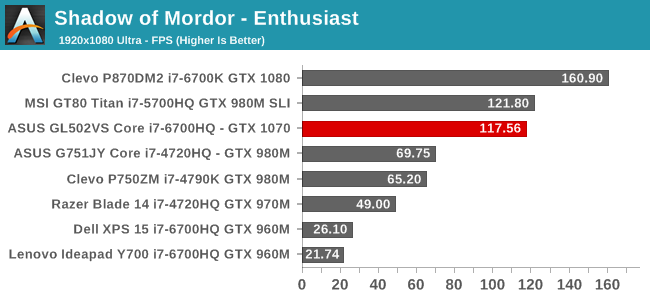
The theme continues, with the GTX 1070 only a hair behind the SLI gaming powerhouse from a year ago.
Grid Autosport
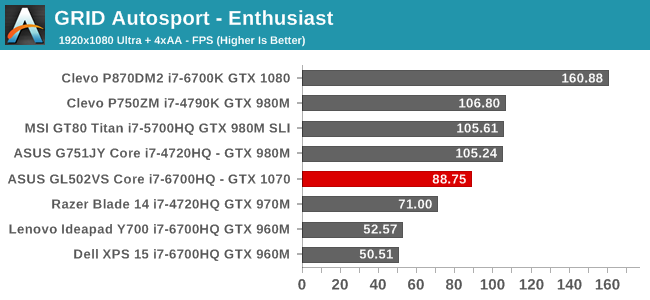
Here we see a bit of a role reversal, with the GTX 1070 falling slightly behind the GTX 980M. This game tends to be CPU bound though, and it’s likely a driver optimization issue here. Regardless, at almost 90 frames per second, it is still not a problem to play.
GPU Conclusion
Maxwell was a big launch for NVIDIA, and the GTX 980M continues to be a pretty powerful GPU, but with FinFET available, Pascal based cards are a huge jump in efficiency. It seems to be pretty consistent in the tests that the GTX 1070 was neck to neck with the SLI GTX 980M, while the GTX 1080 jumps clear of everything by a big margin. The step down to the GTX 1070 from the GTX 1080 is a decent sized step, but regardless the performance of the GTX 1070 is very impressive. Compared to a gaming laptop from a year ago, the ASUS GL502VS is basically on par with the fastest SLI laptops around which is quite an accomplishment.
Most of these games would be playable at UHD resolution (3840x2160) but some of the settings would have to be tweaked for better performance. There isn’t quite enough headroom like on the GTX 1080 to really go for UHD gaming. Just be sure to pick up the 8 GB graphics card to avoid issues in the future, since both a 4 GB and 8 GB model are available.










54 Comments
View All Comments
negusp - Friday, December 9, 2016 - link
In most cases I would agree with you, but not in this case. This laptop is going to be rarely moved. It's effectively a 15-inch DTR.The thing is, a complete desktop system would still be about ~25% cheaper. Even more, dedicated input peripherals and screen make for a much better experience than gaming on a small laptop. Might as well purchase a cheap laptop and build a good rig.
Even more, I can build a $300 PC that can best a PS4, easy. And there are plenty of compatible controllers and MCE remotes that can be used for cheap as a multimedia system.
Samus - Sunday, December 11, 2016 - link
While I agree with your message, you most definitely cannot build a desktop PC for $300 that rivals a PS4 in virtually any media or gaming tasks. Even if you pirate the OS.xenol - Friday, December 9, 2016 - link
Also I didn't realize there was another indent level so I thought your reply was for my comment :PGreat_Scott - Friday, December 9, 2016 - link
At ~$1600 I'm struggling to imagine that anyone cares. Sure, it might even be a good deal, but I can't remember the last time *anyone I know of* spent 4 figures on a laptop. ~$999 at the most or irrelevant.faster - Friday, December 9, 2016 - link
It's gaming laptop. You can't play Battlefield1 on a $999 laptop. This is an intriguing product.p1esk - Sunday, December 11, 2016 - link
Why would anyone want to buy this laptop to play games? It's clearly too big and heavy to lug around if you want to game during your daily commute on a bus, and it's clearly not as fast as a (cheaper) desktop.DanNeely - Sunday, December 11, 2016 - link
Other than being slightly thicker to hold the bigger heat sinks in terms of size/weight this is comparable to a mainstream 15" laptop from 5-10 years ago. OTOH that 10yo mainstream laptop would probably weight 6 pounds instead of 5 like this one does.sundragon - Friday, December 23, 2016 - link
It's about 5.7 lbs when you actually weigh it. I'm not sure why ASUS says 4.8 lbs. The power adapter is large and weighs about 1.2 lbs so we're talking realistically 7lbs if you're moving it.mrcaffeinex - Friday, December 9, 2016 - link
It is not mainstream to me, but it does appear that more of what would have been deemed to be enthusiast in the past is now the upper mainstream.bigboxes - Friday, December 9, 2016 - link
Anything over $1k is not mainstream.